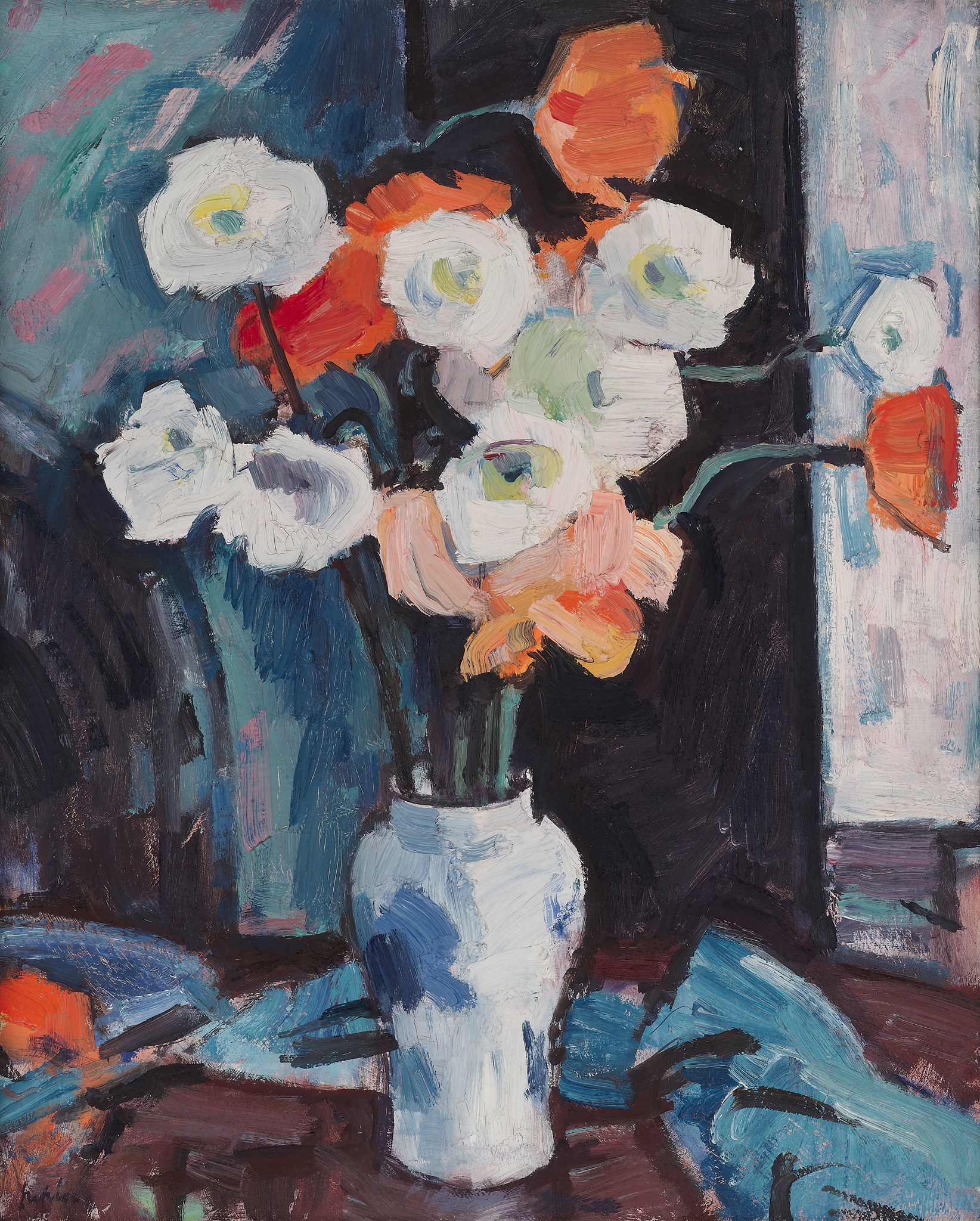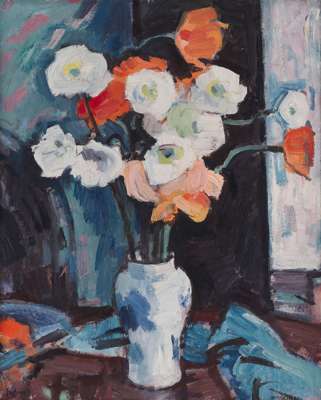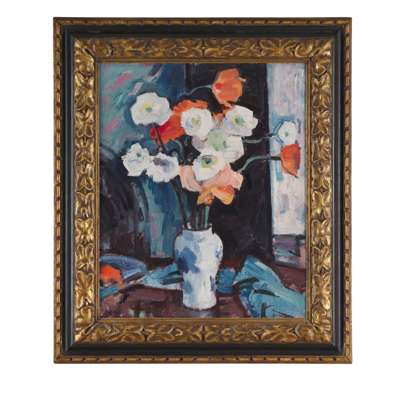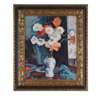
Lot 179

SAMUEL JOHN PEPLOE R.S.A. (SCOTTISH 1871-1935) ‡
ICELAND POPPIES








Scottish Paintings & Sculpture
Auction: Evening Sale | Lots 109 to 207 | Thursday 04 December 2025 from 6pm
Description
Signed, oil on canvas
Dimensions
56cm x 46cm (22in x 18.25in)
Provenance
Acquired from the Artist by Lord Kinnaird
Thence by descent to The Fine Art Society PLC, London (16748)
Acquired from the above by the present owner in 2002
Exhibited:
Alex. Reid & Lefevre Ltd, London, A Few Recent Paintings by S. J. Peploe R.S.A., February - March 1934, no.16
Footnote
FROM A DISTINGUISHED PRIVATE AMERICAN COLLECTION
Iceland Poppies by the Scottish Colourist S. J. Peploe encapsulates his talent as a master of the still life genre. Having trained at the Académie Julian in Paris and in the Royal Scottish Academy Life School in Edinburgh, he made his name with a solo exhibition in the Scottish capital in 1903. Just four years later his first work was acquired for a public collection, namely a still life for the Scottish Modern Arts Association, now in the holdings of Culture Edinburgh (acc.no. CAC4/1964).
Indeed, it is through Peploe’s dedication to the still life that one can trace his extraordinary professional development and success. In 1929 he explained the career-long inspiration he gained from the genre stating: ‘There is so much in mere objects, flowers, leaves, jugs, what not – colours, forms, relation – I can never see mystery coming to an end.’ (as quoted in Stanley Cursiter, Peploe: An Intimate Memoir of an Artist and of his Work, Thomas Nelson and Sons Ltd, London, 1947, p.73).
The poise and sophistication of his still lifes of the early 1900s gave way to an exploration of the very latest innovations in French art through the genre, whilst living in Paris between 1910 and 1912. The Second World War, in which Peploe could not serve on health grounds, provided an opportunity for a deep engagement with the work of Paul Cézanne in this category. By the end of 1918 Peploe had received his first solo exhibition with the leading Glasgow-based art dealer Alexander Reid, whose company was to represent him for the rest of his life; had moved to a studio at 54 Shandwick Place in Edinburgh’s West End; and had been elected an Associate member of the Royal Scottish Academy.
Iceland Poppies dates from an extraordinary period of creativity in the early 1920s when Peploe dedicated himself to the challenge of creating the perfect still life painting. His niece, Margery Porter, provided direct insight into his working method, recalling visits to his studio:
“How well I recollect my Mother and myself climbing those steep stairs and arriving panting at the top to ring his bell in fear and trembling lest our climb had been in vain. But usually he would usher us in wearing a white painting coat and a crownless hat…The studio was a large one, round which I would prowl entranced, after strict warnings not to disturb the still-life group which would almost inevitably be covering the table. My uncle would arrange and re-arrange these groups for perhaps three days before he was satisfied that the balance and construction were perfect, then he would paint them quite rapidly.” (Undated letter from Margery Porter to T. J. Honeyman, National Library of Scotland, T. H. Honeyman Papers, acc.no.9787/45)
Peploe is known to have patronised a flower stall on Princes Street, a few minutes’ walk from Shandwick Place, where he could buy seasonal blooms. Tulips and roses were often selected, but he also enjoyed the painterly thrill of the forms and colours of other varieties, such as the titular poppies in the present painting.
As David R. Mitchell has explained:
"The Iceland Poppy or Arctic Poppy (Oreomecon nudicaulis) has been popular with gardeners since it was first described for science and named as Papaver nudicaule in 1759. The generic name Papaver originates from the Latin word for poppy, whilst the specific name nudicaule appropriately means ‘naked stem’.
The slightly fragrant papery flowers are found in many colours ranging through white, yellow, orange, salmon and pink. Despite looking delicate they actually stand remarkably well in water, a quality that makes them useful as a cut flower…Robert Pace Brotherston, Gardener to the Earl of Haddington noted…in…The Book of Cut Flowers (1906) ‘they last well from three days to a week’. This quality, combined with the delicate translucent appearance of the blooms, particularly the way in which they reflect but also allow the passage of natural light through the petals, would no doubt have made them appeal to the artist’s eye." (David R. Mitchell, ‘Iceland Poppies – Samuel Peploe: Scientific & Horticultural Notes, Cultural Observations & Mythology’, 1 November 2025)
As we can see in Iceland Poppies, Peploe enjoyed the frontal and profile views of the flower heads, arranging a combination of petal colours in an asymmetrical composition in which stems provide structure as well as a sense of movement, especially towards the right-hand edge of the canvas. Thickly loaded brushstrokes are applied in short, bold gestures, sometimes ‘wet on wet’ to create subtle tones, mixed as he worked. Circular flower centres add rhythm to an image which opens out to the Chinese blue and white ‘chrysanthemum’ baluster vase and on to the tabletop and studio setting, realised through an expressive technique which verges on the abstract in certain passages. The contrast of, for example, orange and blue and the placing of brilliant tones throughout the image illustrates Peploe’s highly-tuned skills as a colourist. Moreover, within the language of flowers, poppies are associated with peace, hope, beauty and mortality, as well as love, sleep and creativity, adding symbolism to the work.
Iceland Poppies exemplifies Peploe’s brother-in-law Frederick Porter’s description of his approach to still life painting:
“All his still lifes were carefully arranged and considered before he attempted to put them on canvas. When this was done – it often took many days to accomplish – he seemed to have absorbed everything necessary for transmitting them to canvas. The result was a canvas covered without any apparent effort. The painting was direct and showed no appearance of over-painting. If a certain touch were wrong it was soon obliterated by the palette knife. The whole canvas had to be finished in one painting so as to preserve a complete continuity. If, in his judgement, it was not right then the whole painting was scraped out and painted again. Such a method demanded considerable powers of energy and concentration, but the result in Peploe’s case justified it.” (Frederick Porter, ‘The Art of S. J. Peploe’, The New Alliance, December 1945-January 1946, p.6)
Throughout the 1920s and 1930s, Peploe received regular solo exhibitions, including in Dundee, Edinburgh, Glasgow, Kirkcaldy, London and New York, in which still lifes were the most well represented genre. In 1927, he became a full Member of the Royal Scottish Academy and a still life featuring tulips was acquired by the Tate Gallery (acc.no.NO4224). His work in the field from the later 1920s was characterised by a rusticity of props, lower-toned palette and looser technique. This development was accompanied by a growing international reputation as Peploe achieved the elusive status of critical appreciation combined with commercial success.
The artist’s deep attachment to his paintings is revealed in a letter of 6 January 1930, in which he explained: ‘Paintings are funny things – they have a life of their own with their moods and changes, dependent, too, on so many things, they need looking after and being loved, like children.’ (Peploe to ‘Sir’, Manchester Art Gallery, 6 January 1930, S. J. Peploe Archive, National Galleries of Scotland, GMA A112).
Iceland Poppies was included in Peploe’s last lifetime solo exhibition in London, A Few Recent Paintings by S. J. Peploe R.S.A., held at Alex. Reid & Lefevre Ltd from February to March 1934 (no.16). It was acquired from Peploe by Lord Kinnaird, believed to be Kenneth Fitzgerald Kinnaird (1880-1972), 12th Lord Kinnaird and 4th Baron Kinnaird of Rossie, Perthshire. He was the son of Arthur Fitzgerald Kinnaird (1847-1923), 11th Lord Kinnaird, the celebrated footballer who served as President of the Football Association for thirty-three years.
Peploe’s death in Edinburgh in 1937 was widely lamented in the press and was marked with memorial exhibitions at the Royal Scottish Academy, Royal Glasgow Institute of the Fine Arts, The Scottish Gallery, Edinburgh and the McLellan Galleries, Glasgow. Examples of his still life paintings are held in numerous public collections including that of the National Galleries of Scotland.
We are grateful to David R. Mitchell, Curator, Muddy Feet Consulting for his help with our research.








